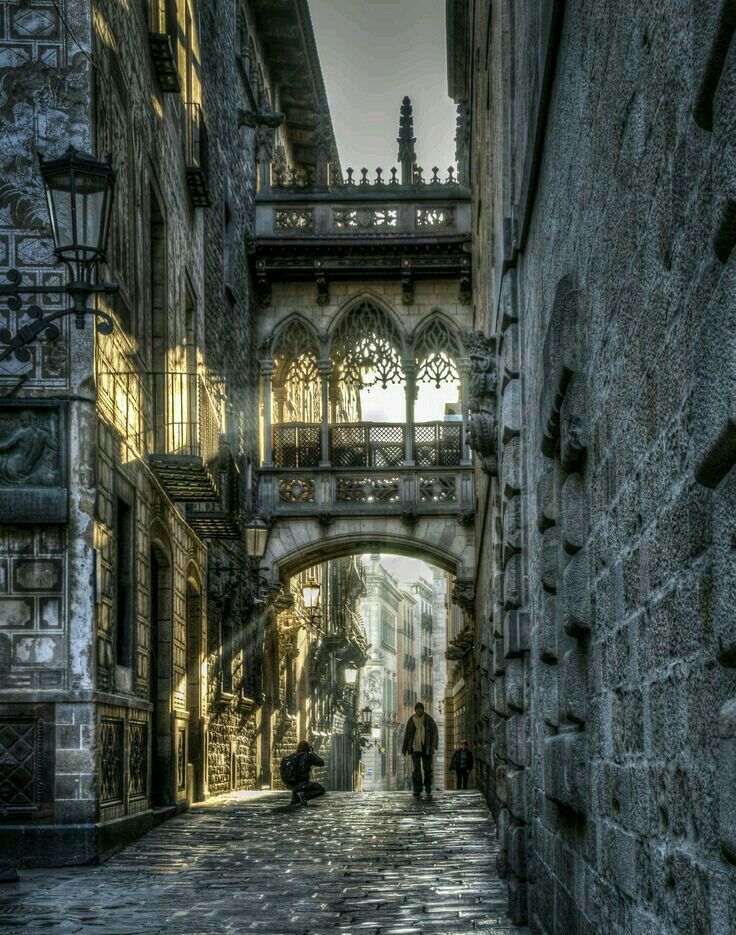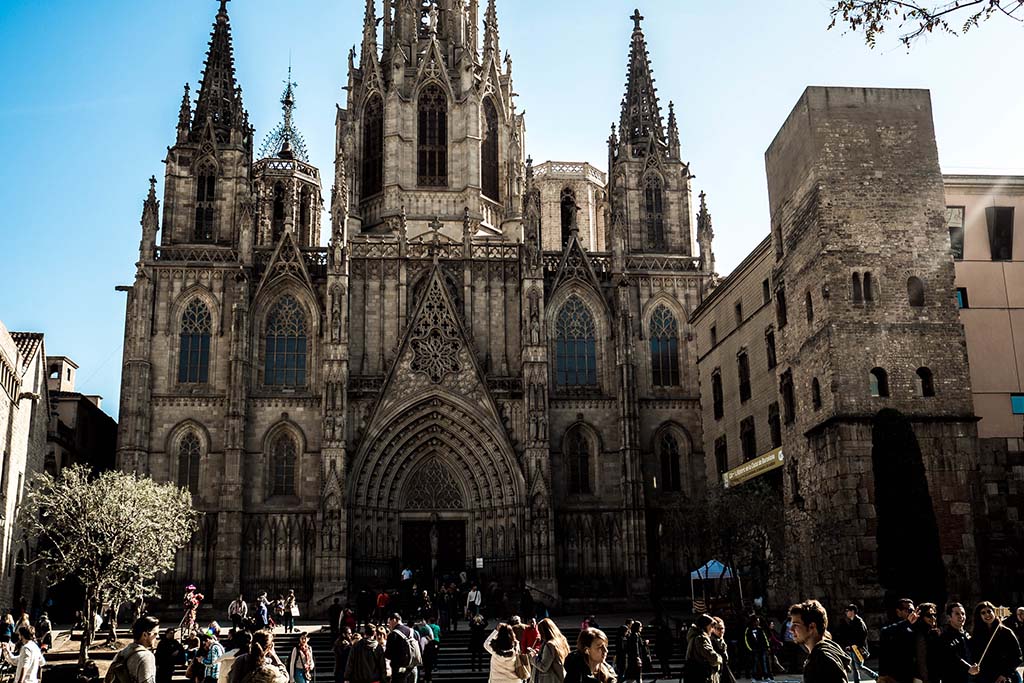13 MUST SEE Things to Do in the Barcelona Gothic Quarter
The Barcelona Gothic Quarter is the heart of the old city – and it’s also the heart of the new city.
The Barri Gotic is a medieval neighbourhood with kitschy modern bars. It’s the site of city hall meetings and rambunctious nights out. It’s where winding streets, open minds, and empty stomachs meet their match.
Let’s break down what to see in the Gothic Quarter of Barcelona.
Things to Do in the Gothic Quarter in Barcelona Spain
The Barcelona Cathedral
The Barcelona Cathedral was dedicated to Eulalia of Barcelona: co-patron saint of the city, who according to legend was left naked in a public square only to be covered by a miracle mid-spring snowfall.
Photographers should note that it’s fantastic under the light of dusk. The real highlight is the splendid inner courtyard with 13 white geese, one for every year of Eulalia’s life.
Similar to Sagrada Familia, this building took 150 years to build, so taking 15 minutes to walk through is the least you can do.
Outside? Look up to see the epic gargoyles watching over the Gothic Quarter – they’re actually there to prevent rainwater from running down the masonry.
Walk Las Ramblas
So technically Las Ramblas, Barcelona’s most famous street, is the dividing line between the Barrio Gótico and Raval.
Don’t expect to escape its charms whether it’s the flower market, the street artists, or Joan Miro’s abstract street mosaic El Pavimento Miró.
That said, don’t buy even as much as a bottle of water here. It’s tourist trap central. Go to nearby Boqueria Market and get fruit smoothies, Iberian ham, and some seafood tapas – but keep your wallet holstered otherwise.
Related: Get a two hour walking tour of the Gothic Quarter for just 18 euro.
Walk Under the Pont del Bisbe
Regarding what to do in the Gothic Quarter, tons of tourists seem to think that Instagramming from this spot is mandatory.
The Pont del Bisbe, an ornamental bridge (Bishop’s Bridge in English) built in 1929 in Gothic style, connects the House of Canons with the Palau de la Generalitat.
Make sure to look up! The embittered architect Joan Rubió i Bellver left a nasty skull and dagger surprise underneath – apparently to curse anybody who walked under, after the city rejected all his other proposals.
Explore Picasso’s Old Haunts on Carrer d’Avinyo
One of the most interesting streets in the Barcelona Gothic Quarter is famous for a fine arts school – which gave instruction to a young Pablo Picasso, among others.
For decades it was the cultural heart of the city and home to many cafes where artists gathered to network, socialize, and get up to all sorts of no good.
In fact, one of Picassos most famous works Les Demoiselles d’Avignon portrays five nude prostitutes from an Avinyo brothel – you can see it at the Barcelona Picasso Museum.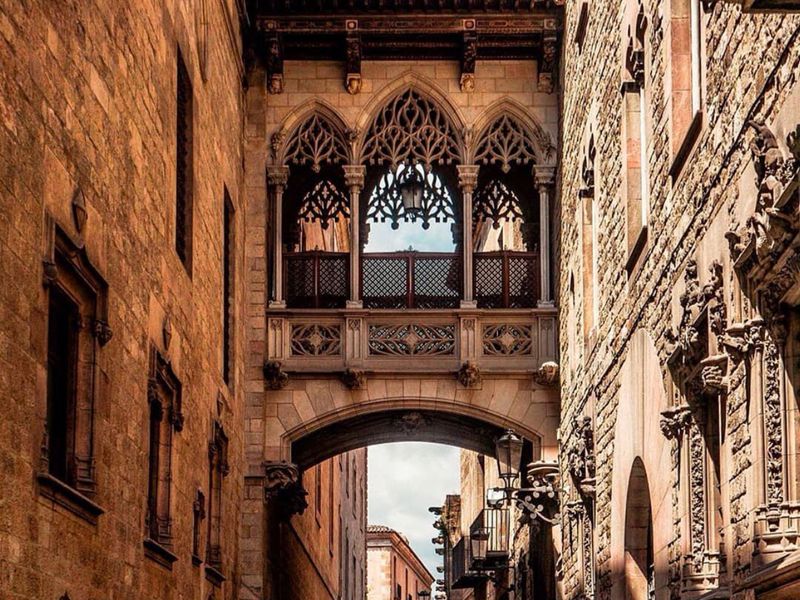
El Bosc de les Fades
One of Barcelona’s most unique bars. Gothic Quarter? You’ll swear you’re drinking in the middle of a forest. The simulated rain showers are a cool effect, but at least you won’t need an umbrella to try the sangria.
What surprises here are the reasonable drink prices for being such a sought after location. It’s connected to the Barcelona Wax Museum but tickets aren’t required to enter.
The Barcelona History Museum
Learn 2000 years of Barcelona history with a visit to the Museu d’Història de la Ciutat (MUHBA).
One ticket gets you access to seven different locations, mostly in the Gothic Quarter. The most popular may be the underground walk of the old Roman streets. See old wine shops, homes, and even a guard tower.
Find out more information at the official MUHBA website.
Barcelona’s Roman Temple
One of the Gothic Quarter’s hidden gems is the Temple d’August.
You’ll find it hidden in a medieval courtyard behind the Barcelona Cathedral, on a narrow street called Carrer Paradís.
These nine meter high columns are some of Barcelona’s earliest relics showing its founding as a Roman city. The columns themselves are over 2000 years old.
Best of all? Entrance to the courtyard is free – it’s one of the best free things to do in Barcelona.
Watch the Sardana
A symbol of national unity and pride, this traditional Catalan folk dance was actually banned by dictator Francisco Franco until as late as 1975.
The inclusive (no formal clothing is required) circular dance has its participants holding hands carrying out a series of demanding and meticulous steps set to music.
Tourists now get to see it for free every Sunday – a cheap alternative to a night out seeing Barcelona flamenco.
Location: Pla de la Seu (in front of the Cathedral).
Sant Felip Neri Square
This is one of the best things to do in the Barcelona Barrio Gotico, hands down.
Just steps away from the tourist hustle and bustle, around the corner of an ordinary alleyway you’ll find one of the most tranquil squares in Barcelona.
The first thing you’ll notice at Plaça Sant Felip Neri is the quaint little fountain the middle.
That said, take a closer look at the walls – those indentations aren’t weather erosion. They’re actually shrapnel marks from a Spanish Civil War bombing that killed 42 people back in 1938.
Go for a Drink
As we found out with Picasso, it’s no secret that the narrow streets of the Barcelona Barri Gòtic lend themselves well to all sorts of vice – Barcelona stag dos, I’m looking at you.
Some of Barcelona’s best bars are here. Whether you’re looking for a cheeky homemade vermouth and olives at Bodega Visconia or a craft cocktail with an exhibition thrown in at Tin Can you’ve got options.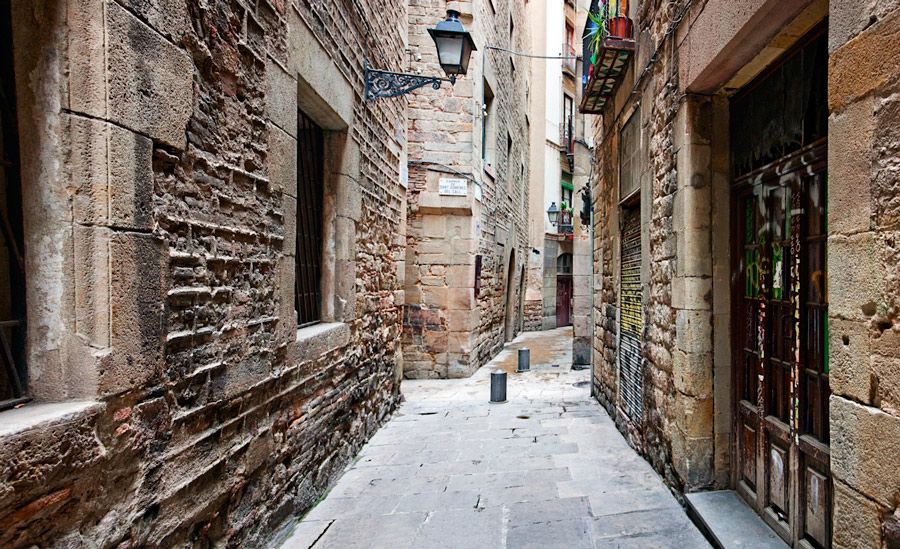
That said, for a casual beer to break up the Gothic Quarter attractions I’m going to Plaça de George Orwell every time. Get a seat on the patio at Bar Oviso – this where locals roll.
Take the Secrets of the Old City Guided Tour
There’s no better way to get your hand on the pulse of the history, the current political situation, and the future of Barcelona than with a 2.5 hour Gothic Quarter tour (video here) with a pro.
These walking tours are with one of the best guides in the business: local Texan Alvaro.
Prepare to be ‘edu-tained‘ with secrets of the old city at La Rambla, Boqueria Market, Barcelona Cathedral, Plaça Sant Felipe Neri, Augustus Temple, the Jewish Quarter (El Call), and much more.
You’ll also get an old Picasso haunt, one of Barcelona’s sweetest snack stops, and street art galore.
Go Gothic Quarter Shopping
In and around the Gothic Quarter you’ll find some of the best shopping in Barcelona.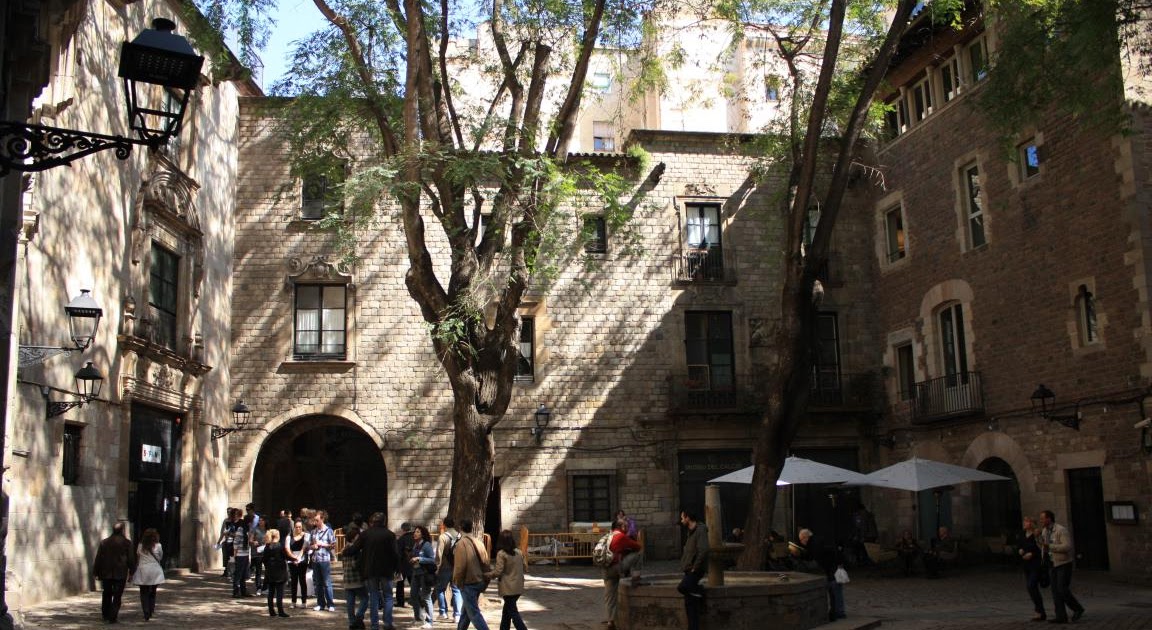
Just off Plaça Catalunya is the famous pedestrian only street Portal de l’Angel: Barcelona’s equivalent to Oxford Street. Not only is it full of shops but it connects the square to city’s historic centre.
Here you’ll find all the big names like H&M, Zara, Bershka, Benetton, Mango, Pull and Bear etc.
For more of a vintage and artisan vibe make sure you take a stroll down Calle Avinyó for a look at the many boutique shops there. Retro style pin up shoes are big at La Veintinueve and one of the best retro clothing stores is at Love.
Soak Up Plaça Reial
The Gothic Quarter in Barcelona is full touristy squares but Plaça Reial (‘Royal Square’ in Catalan) isn’t one of them – this massive, slightly exotic, elegant beauty is one of the most vibrant places in the city.
Whether you just want to sit at the central fountain and watch the world go buy, have a drink on one of the terraces (go for Ocaña), or have a full on Barcelona paella dinner at Les Quinze Nits it’s all there.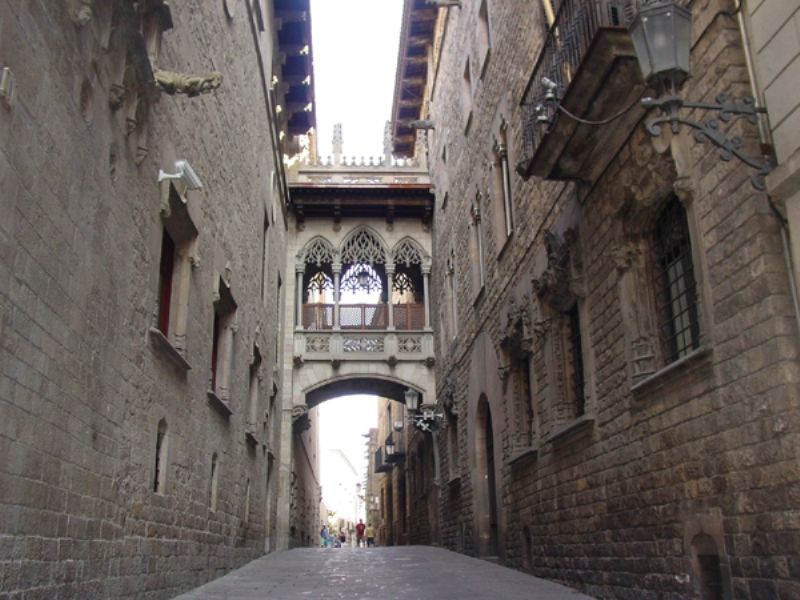
Look out for the decorative street lamps – they were some of the first works of Antoni Gaudi ever commissioned.
Gothic Quarter Map
Barcelona’s Gothic Quarter, known locally as El Barri Gòtic, is part of the old town (‘Ciutat Vella’) along with Barceloneta, El Born, and El Raval.
How to Get to the Gothic Quarter
The neighbourhood is bordered by the Liceu (green line L3), Catalunya (red line L1 or green line L3), and Jaume I (yellow line L4) metro stations. Any of these could be useful depending on the area you stay.
The easiest transport from Barcelona airport to El Gotic is to get off the Aerobus or city bus at Plaça de Catalunya, then dip down into the Gothic Quarter at any point by taking a left going downhill on the famous Rambla.
A taxi from the airport to the Barcelona Gothic Quarter should cost about €30.00.
Gothic Quarter General Information
Barrio Gòtico History
Born from the ashes of Barcino, the old Roman settlement of the area dating back to 15 BC, the Gothic Quarter still shows off some classic urban structures associated with the Roman Empire.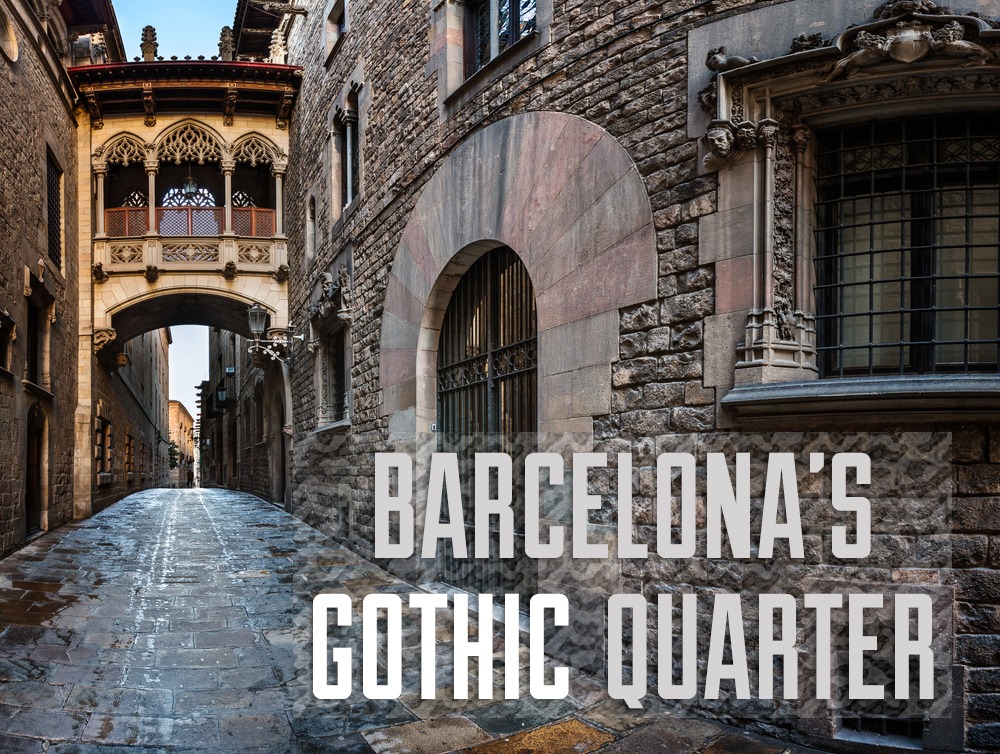
It’s not only Barcelona’s historic center but the heart and soul of the Catalan capital and the centre of political and religious life in Barcelona since medieval times.
When you walk around the area it’s easy to come across massive Gothic churches and Roman walls from the first century AD.
What the Barcelona Gothic Quarter is Like Today
Today the Barcelona Gothic Quarter is a (mostly) car-free pedestrian playground and the beating heart of the city and tourism industry. It’s completely walk-able but if you need a rest simply duck into one of the many bars.
When night falls it becomes slightly mysterious: the light play of its locales creates shadows that’ll make you feel like you’re the lead actor in a horror film, only this is much more realistic.
Gothic Quarter Barcelona FAQ
What is the Gothic Quarter in Barcelona?
The Gothic Quarter is one of the five districts of the old city, and it’s the most historical neighbourhood in Barcelona being the site of the original Roman settlement Barcino, which gave way to modern Barcelona.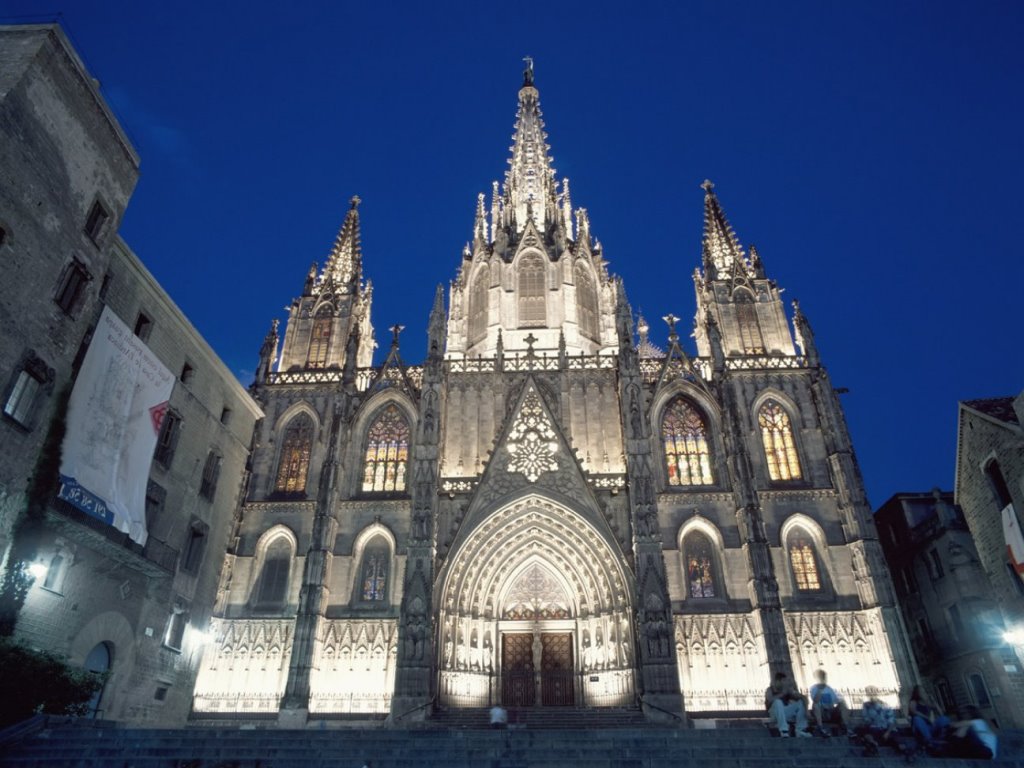
Where is the Gothic Quarter in Barcelona?
Barcelona’s Gothic Quarter (or Barrio Gotico) is found in the city centre between Las Ramblas and Via Laietana to the east and west, and the Barcelona Port and Ronda San Pau to the north and south. The main metro stations are Liceu, Drassanes, Placa de Catalunya, and Jaume I.
What is the Gothic Quarter in Barcelona like?
The Gothic Quarter (Barri Gòtic in Catalan) is a charming, historical Barcelona neighbourhood full of narrow, winding medieval streets. It’s a bustling area with street musicians, artisans, boutique shopping, and a huge concentration of bars and restaurants.
Is the Gothic Quarter in Barcelona safe?
In general, people taking standard precautions should not run into trouble in the Gothic Quarter. That said, especially during tourist season there is a notable pickpocket risk at major metro stops and squares like Plaça de la Seu.
Where to eat in the Barcelona Gothic Quarter?
Being a major tourist thoroughfare there are ton of tourist trap restaurants so precautions should be taken.
What is there to see in the Gothic Quarter Barcelona?
For those wanting to visit the Barcelona Gothic Quarter they should see the Barcelona Cathedral, the Temple d’August, Plaça Reial, Plaça Sant Felip Neri, Las Ramblas, and the Pont del Bisbe. They should also check out the shops and bars along the famous Carrer d’Avinyo.
Visiting the Gothic Quarter Barcelona?
There you have it.
You’ve finally got a list of things to do in the Gothic Quarter Barcelona but the quest never ends does it? If I’ve blatantly missed something incredible don’t hesitate to drop me a line below.
Also – any questions you have about your Barcelona holiday will be answered ASAP.
Don’t be shy 🙂
The district Barri Gòtic in the Old Town
Barcelona’s history began where the Barri Gòtic is today, in between the Rambla in the west and Via Leietana in the east.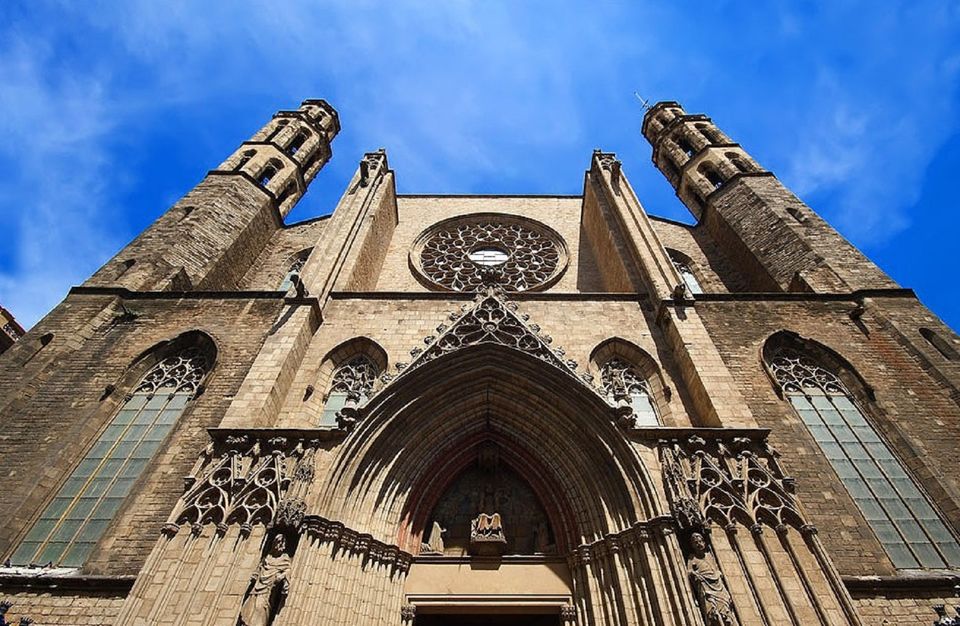
The land all around the settlement was endorsed to the former legionaries, who had a right to claim a piece of land after 16 years of service. The former main streets, the “Decumanus Maximus” and the “Cardo Maximus”, still run through the district today. The largest Roman digs outside of Rome are located in Barcelona. However the most remaining monuments descend from the 14th and 15th century, the time of the Catalonian gothic and the bloom years of Barcelona as a maritime power. Nevertheless you can find well preserved sights from other epochs of the city’s history.
Barri Gòtic’s urban image today
Many narrow and winding alleys shape the district’s urban image today.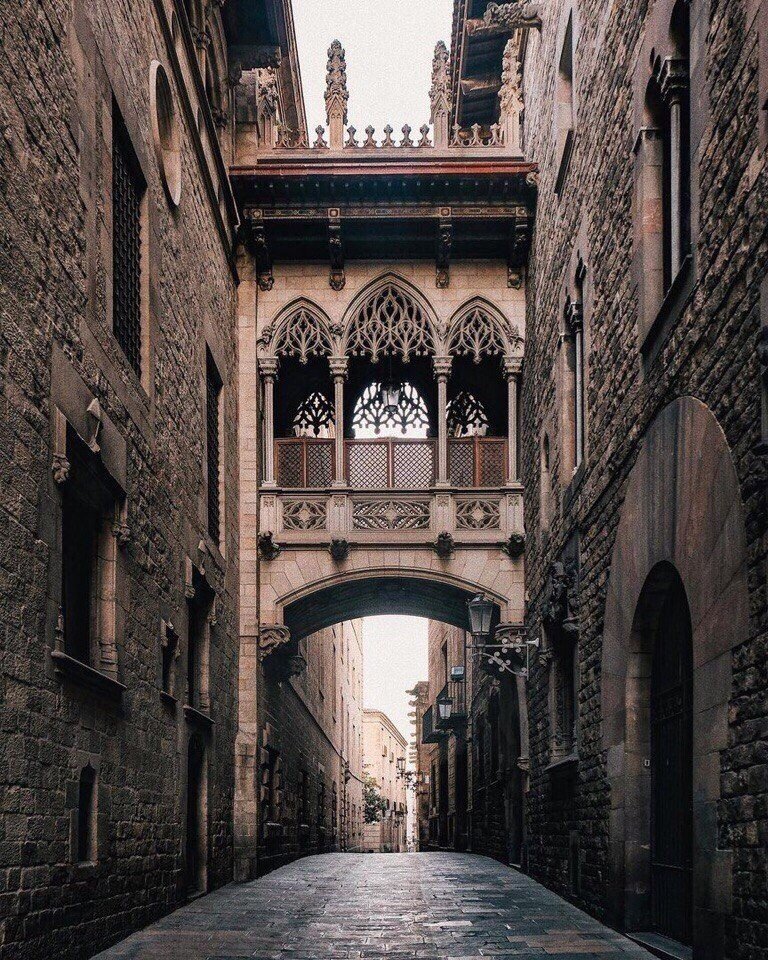
Many of the most beautiful and most famous museums are located in the medieval district. There are only a few roads used by car, so you can discover Barri Gòtic almost everywhere by foot.
The Barri Gòtic is absolutely suited for shopping: uncountable little boutiques, stores with items for the daily needs and chocolate stores make spending money easy.
The district is worth a visit even at night: uncountable bars and pubs invite for a drink or tapa. You will find a lot of classic Catalonian food on the menus of the restaurants.
Barri Gòtic’s history
The Romans dominated the city for about 500 years – from its founding about 133 BC until the capture of the Visigoths 410 AD.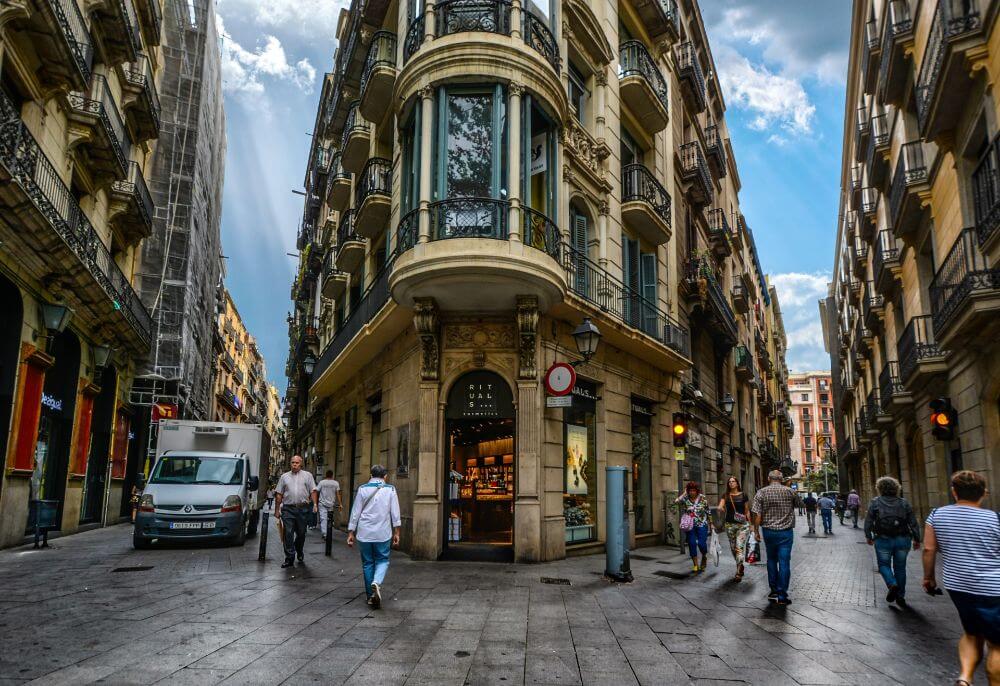
In 714 the city was surrendered to the Moors without a fight, that’s how Barcelona escaped a demolition. The Early Christian cathedral on the grounds of the cathedral today was transformed into a mosque. The Moorish reign lasted less than 100 years, that’s why there aren’t any noteworthy testimonials of the era.
In the 12th century Barcelona became the most important power of the Mediterranean. The former shipyard Drassanes is the visible evidence of the time as a maritime power.
Starting in the 19th century, the industrialisation (textile industry) granted wealth and influence once again. In many places you can see the old smokestacks. The city walls were torn down from 1854-1856.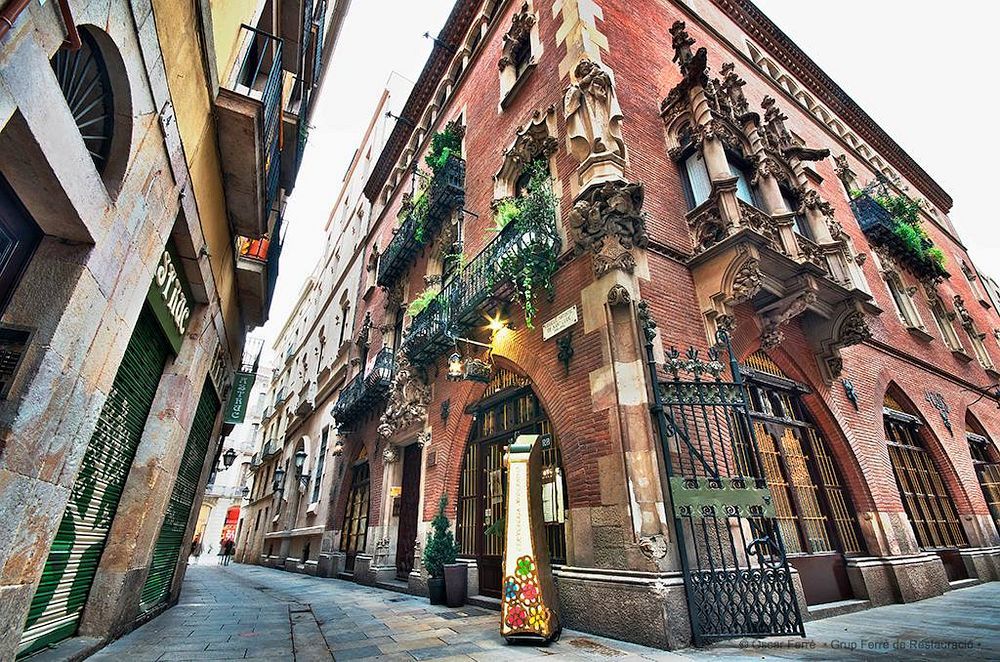
The area around the harbour was thoroughly renovated for the Olympic Summer Games in 1992.
El Call – Barcelona‘s Jewish district
The Jewish district, also called “El Call”, is located midst the gothic districts. It starts at the north western corner of the Plaça Sant Jaume. Ell Call means “little street” or “alley”. It deduces from the medieval shaped narrow and winding alleys, which form the urban image of El Call. El Call breaks down into the “call Major” with the synagogue and the “Call Menor”, a little district towards the Ramblas. The Call Menor was formed after settling outside of the city walls was allowed.
In the 13th century about 4,000 Jews were living in Barcelona, which is about 15 percent of the former town population. A majority worked as doctors, scientists, scholars, merchants or money lenders for the Catalonian aristocracy and the crown. As a result of this and because of trading contacts to the Middle East and North Africa they were an important component of the economy.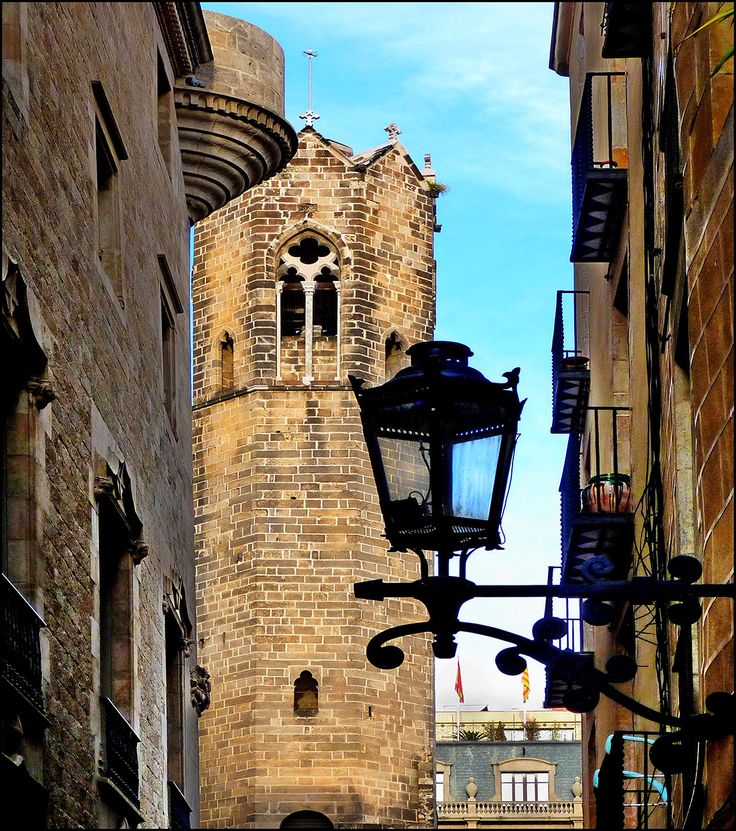
In 1424 all Jewish families had to leave Barcelona because of the persecution of the Jews. Valuable trading contacts and knowledge went lost.
By order of the king no Jewish chapels were allowed to be larger than the smallest Christian church in Barcelona, which explains why the most important synagogue of the Jewish district is comparably small. Since 2002 the synagogue Major – Spain’s oldest synagogue and one of the oldest ones in Europe – in the centre of the Jewish district is open for visitors.
Today you can especially find little galleries and antique shops in the Jewish district.
Barri Gòtic’s sights
In no other district are as many monumental buildings and interesting museums as close to each other as in Barri Gòtic.
Guide to the Gothic Quarter (Barri Gotic), Barcelona
Page Content
| Artists Pi in Barri Gòtic |
Known as the Gothic Quarter, this beautiful area is so named because it was once a Roman village, which means it still retains remnants of a glorious past.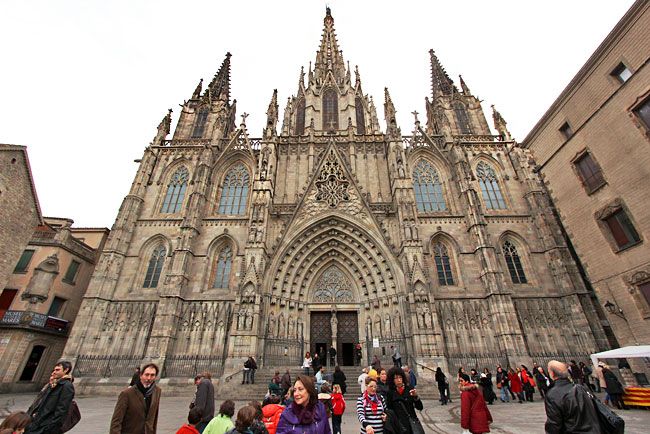
Click to book tickets online for a private walking tour of the Gothic Quarter with a visit to the Cathedral of Barcelona
Narrow and winding streets form a real labyrinth, and it will not be easy to find your way here. I advise you to look up and around, otherwise you can miss all the fun.
The Gothic Quarter has many quiet squares (plaças) where you can relax and enjoy the surroundings. However, one of the main attractions, located in the heart of the quarter, is the cathedral, with a magnificent courtyard with many plants and, oddly enough, geese.
| Mix of old and new: Modern shops in Barri Gòtic |
The abundance of restaurants and bars will make your eyes widen, especially near Plaça Reial, which is full of people day and night.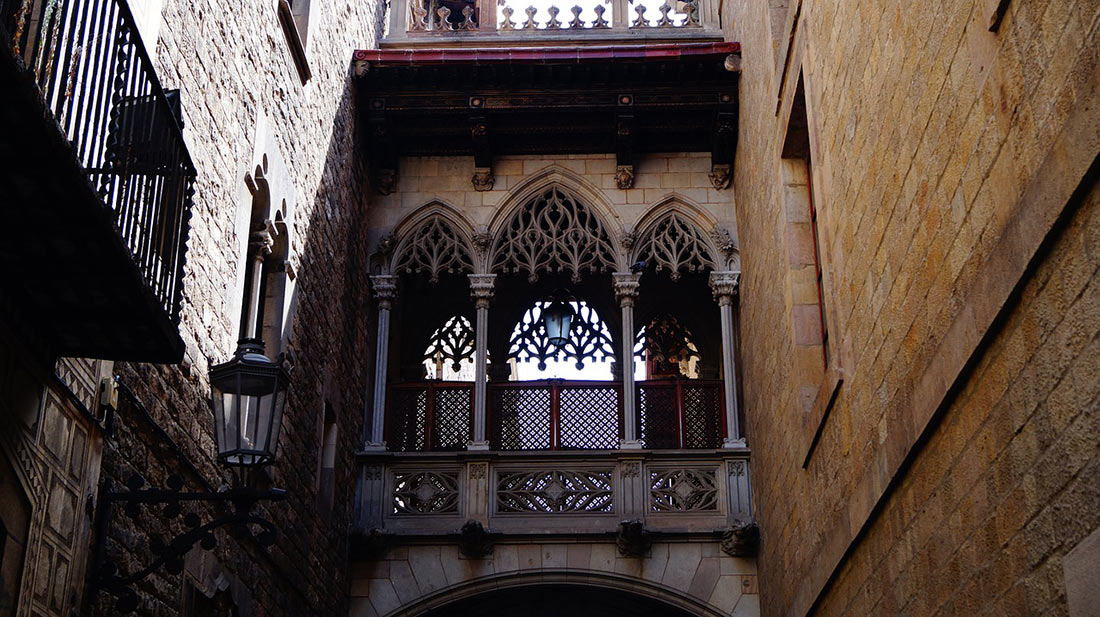
The shops in the Gothic Quarter are great too, from the commercial area of Calle Portal de L’Angel to the little boutiques on Calle Avinyo. Be sure to walk around to see everything. The Gothic Quarter is perfect for a midday walk.
There are metro stations on both sides of the gothic quarter, 3 stations are located on Las Ramblas, which stretches along one side of the area, and on the other side there is Jaume 1 station. However, you are in the very center of the city and most of the sights are located on foot accessibility.
| Plaça Reial in Barri Gòtic |
At the very beginning of Las Ramblas is Plaça Catalunya, from where you can get to Passeig de Gràcia if you are interested in shopping for more designer items or if you want to see Gaudí’s buildings.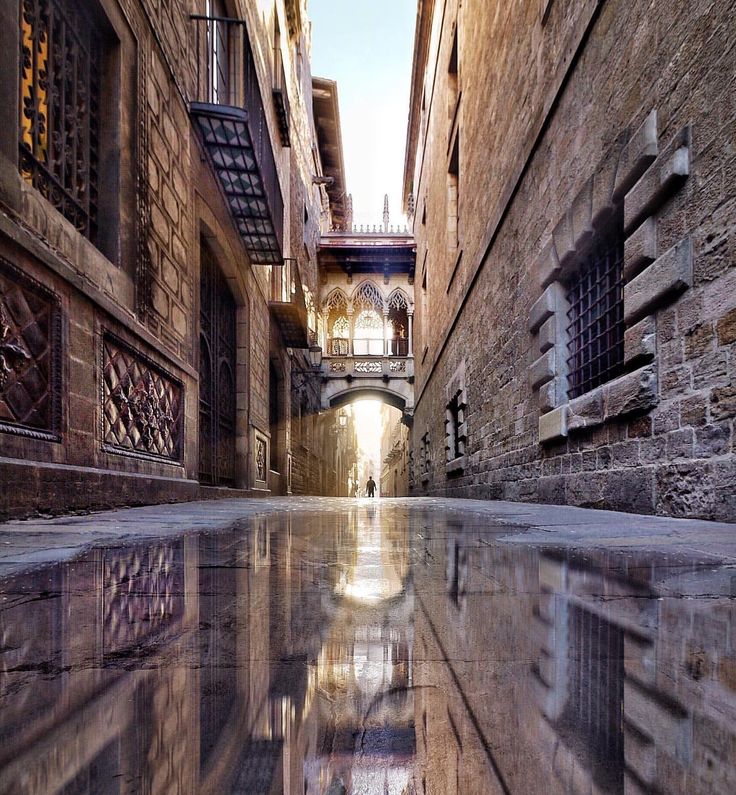
El Raval is another interesting area worth seeing. You can get into it by going to the other side of Las Ramblas.
The Barri Gòtic area is the first choice of many tourists visiting Barcelona. This is the cultural center of the city, which is sure to please any traveler.
Map of Barri Gotic area in Barcelona
Mirador de Colom
Plaça Portal de la Pau
Museum d’Historia de Catalunya
Plaça de Pau Vila, 3
Plaza Catalunya
Basilica de Santa Maria del Pi
Plaça del Pi, 7
Plaça Real
Gran Teatre del Liceu
La Rambla, 51 – 59
La Boqueria Market
La Rambla, 91
Picasso Museum
Carrer Montcada, 15-23
Barcelona History Museum
Plaça del Rei
Barcelona Cathedral
Plaça de la Seu, 3
Catalunya Metro
Parking Coliseum
Parking lot SABA Plaça Urquinaona
Passeig de Gràcia Metro
Passeig de Gràcia Metro
Parking SABA BAMSA Rambla Catalunya
Port Vell District
District El Born
District La Ribera
Parking NN Palau de la Música
Parking SABA BAMSA Francesc Cambo
Parking Laietana Princesa
Parking BSM Moll de la Fusta
Parking lot SABA Plaça Catalunya
Parking Eden
Parking SABA BAMSA Illa Raval
Parking BSM La Boqueria
Parking lot SABA BAMSA Plaça dels Angels
Parking NN Bonsucces
Universitat Metro
Drassanes Metro
Barceloneta Metro
Urquinaona Metro
Urquinaona Metro
Jaume I Metro
Liceu Metro
Catalunya Metro
Catalunya Metro
Eixample right
Eixample left side
Parking SABA Catedral
Barri Gothic
El Raval District
This map is copyrighted and protected, copying is prohibited.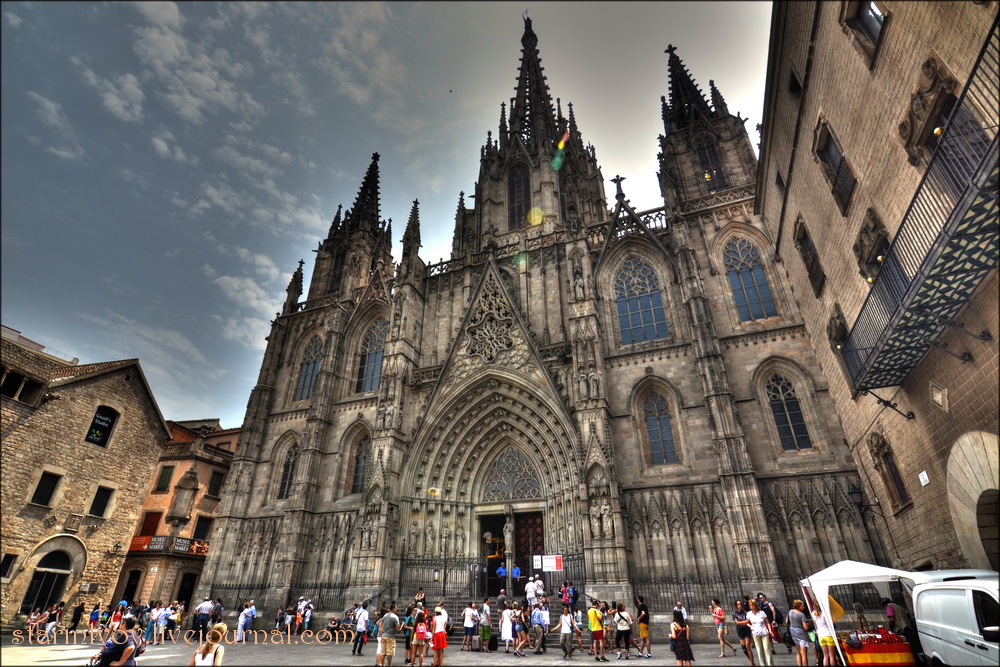
Hotels near the Gothic Quarter
To read a review of a hotel, just click on its name.
Adagio Hotel – 2 stars
Colon Hotel – 4 stars
Gotico Hotel – 2 stars
h20 Montcada Hotel – 4 stars
Meridien Hotel – 5 stars
Monte Carlo Hotel – 3 stars
MontBlanc Hotel – 3 stars
Neri Hotel – 4 stars
Nouvel Hotel – 3 stars
Rialto Hotel – 3 stars
Serhs Rivoli Rambla Hotel – 4 stars
Royal Hotel – 4 stars
Suizo Hotel – 3 stars
Main attractions:
Barcelona Cathedral
Roman Architecture
Cafes and bars
Click to book tickets online for a private walking tour of the Gothic Quarter with a visit to the Cathedral of Barcelona
Gothic, Raval and Born 🧭 tour price €120, 28 reviews, tour schedule in Barcelona
Barcelona of many faces: Gothic, Raval and Born 🧭 excursion price €120, 28 reviews, schedule of excursions in Barcelona
Legends and myths of the three most amazing areas of the city
Tripster tour in Barcelona
Three quarters – Gothic, Raval and Born – keep an incredible amount of history and attract travelers from all over the world.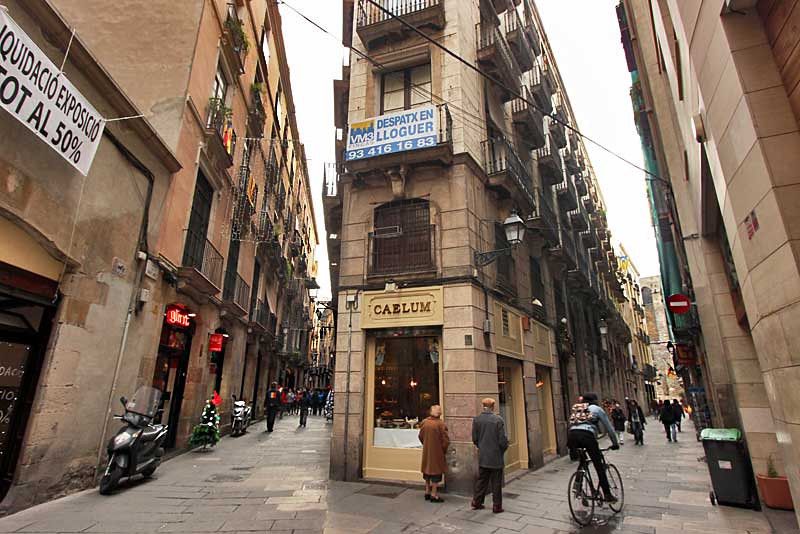
Three Quarters
The Gothic Quarter is the heart of medieval Barcelona. Here lived aristocrats and ministers of the church, artisans and intellectuals. Most of the quarter’s buildings were built in the Middle Ages. The crooked streets of Gothic still keep legends about the counts of Barcelona, great battles and holy martyrs.
But in Raval from ancient times settled those who had no place in the city – murderers, thieves and swindlers. Here were the noisiest bars and cheap brothels in Barcelona. Sailors also loved to walk in Raval, whose ships came to the port. By the beginning of the 20th century, even the police were afraid to look here! But don’t worry, Raval is safe now. Although old houses can tell a lot about his dark past!
Born , however, remained a haven for “people of the sea” – fishermen and sailors.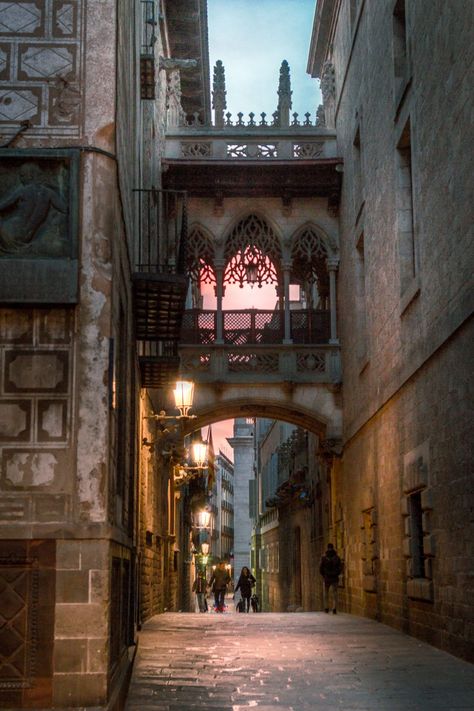
Program
During our walk we will visit the most important sights of three districts:
- In Raval, we will drink water from the Canaletas fountain, visit the famous medieval Santa Cru hospital, go to the most luxurious bar, where Pablo Picasso was a regular, rub the whiskers of the giant cat Botero and see one of the masterpieces of Antonio Gaudi.
- In Gothic – we are waiting for the magnificent Cathedral and 13 geese that live in its courtyard, then we will walk along the square near the Royal Palace, sit on the famous stairs that Christopher Columbus walked on and see the oldest house in Barcelona.
- In Born, we will visit the amazing Cathedral of Santa Maria del Mar, built in the XIV century, see the memorial to the fallen defenders of the city, walk along the famous Passeig del Born and reach the Ciutadeia park, which used to be a military fortress.
Meeting point
Start of the tour Plaza Catalunya. You will know the exact meeting point immediately after booking.
Still have questions?
Ask questions to the guideYou can chat with the guide before paying for the order and get answers to all your questions
Book an excursion on any of the available days in the calendar
- This is an individual excursion in Russian, the guide will conduct it for you and your company.
- On the site you pay 23% of the cost, and the rest of the money – to the guide on the spot. You can ask the guide any questions before paying.
Busy day
Free day
28 traveler reviews
Only travelers who have visited the tour can write a review. Read more
I really liked and remembered the tour with Mila.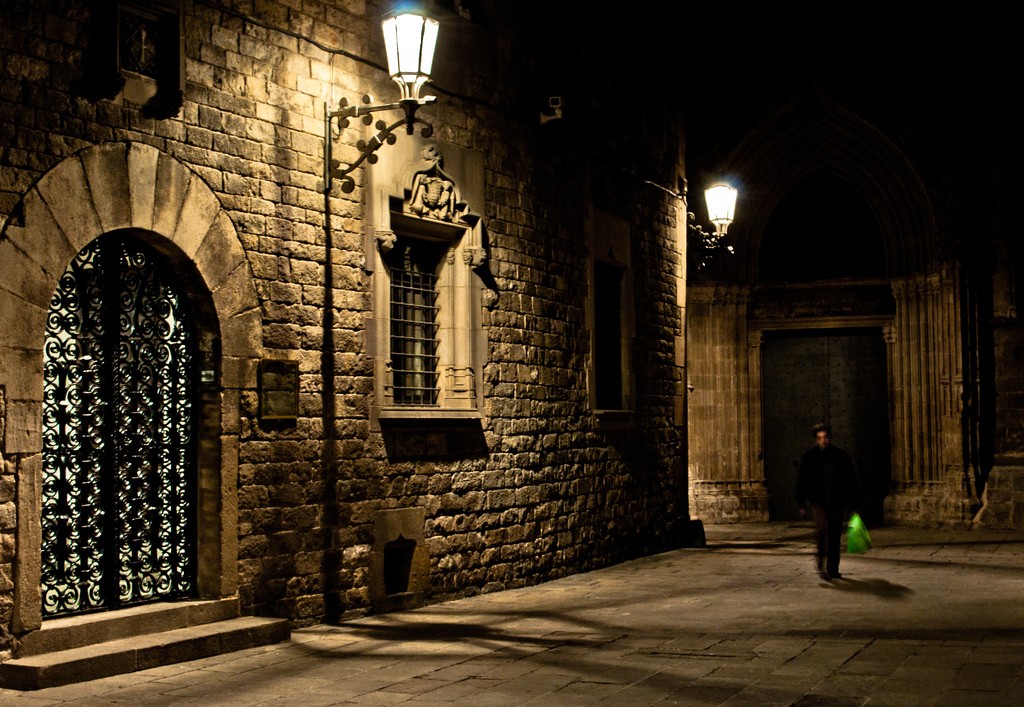
more
Great tour! Be sure to take it! Very smart, clear, not boring. Everything lined up in my head instantly: both historically and territorially. An excursion with a local professional guide allows you to immerse yourself in the city, get to know it without haste and throwing). Many thanks to Mila. I will definitely recommend to all my friends when they go to Barcelona.
more
Great walking tour! An excellent guide Mila, a professional in her field! During the tour, we learned a lot of new things, despite the fact that we were not in Barcelona for the first time.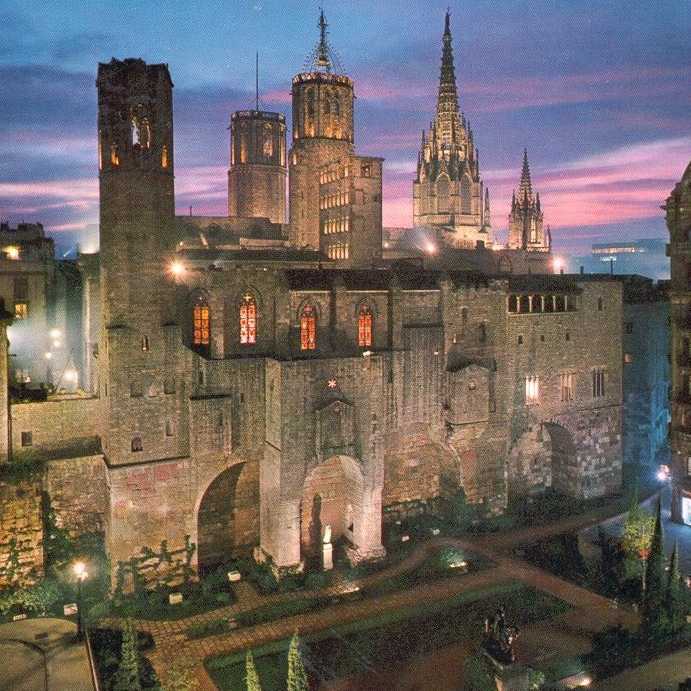
more
Three hours of the tour flew by. Mila plunged us into the history of an incredible city that boggles the imagination. who gave the world so much, showed the connection of its history with culture, architecture, and modernity. It was very exciting and interesting. The route is thought out and logical. Mila is a wonderful professional, an interesting storyteller and a charming person. Unfortunately, we no longer have the opportunity to conduct another tour with her, but we will definitely use the recommendations. Thank you Mila and all the best.
more
Mila is a wonderful guide who loves Barcelona and her job. Thanks to her)
more
. Thank you Mila for a great and informative tour.
more
Very interesting tour, thanks to the guide Mila! He will take you to the most interesting places, show and tell absolutely everything.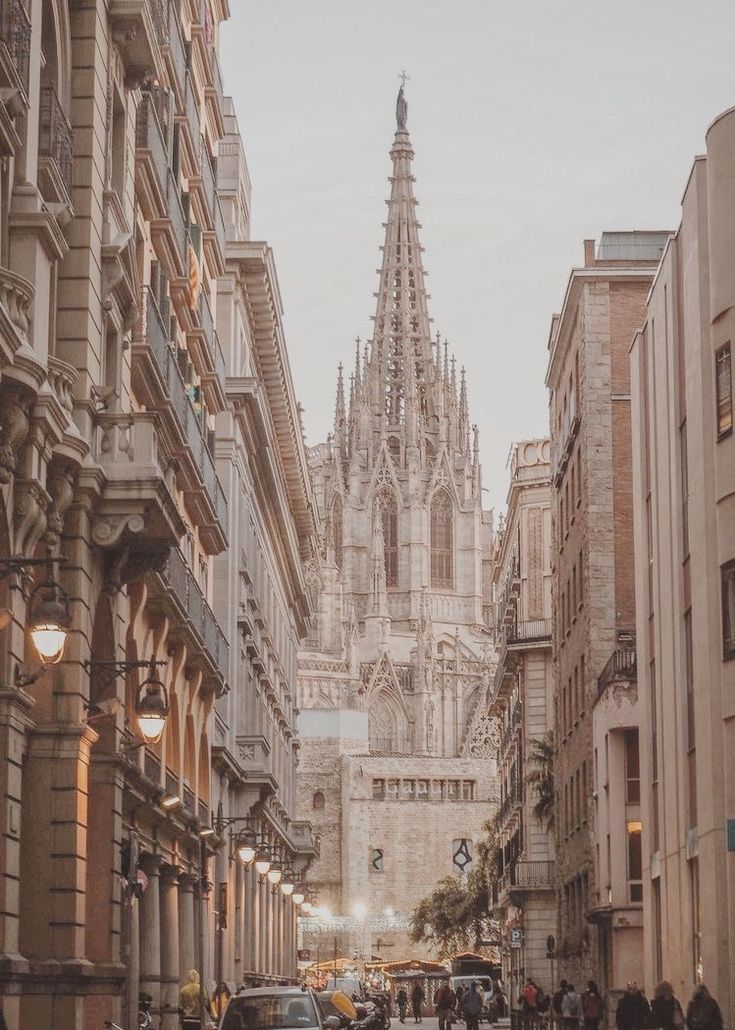
more
We spent two wonderful days with Mila – on tours of the three districts of Barcelona and the masterpieces of Gaudí. From the first minutes, Mila was able to “infect” us with her love for Barcelona.
I would like to note her professionalism, excellent knowledge of history, excellent voice and fascinating presentation of the material. Recommended.
more
We arrived in Barcelona at the end of June for 3 days and decided on the first day to explore the historical part of the city with a guide. I myself was already 2 times in Barcelona and knew the city center quite well. But this time I was with a 7-year-old child and friends, and we decided to book the “Many Faces of Barcelona” tour through Tripster.
The tour was a breeze. Our guide Mila was a very pleasant person. Interesting, informative tour. Mila showed the historical center of the city with a visit to the old streets, squares, houses, while telling interesting facts and legends.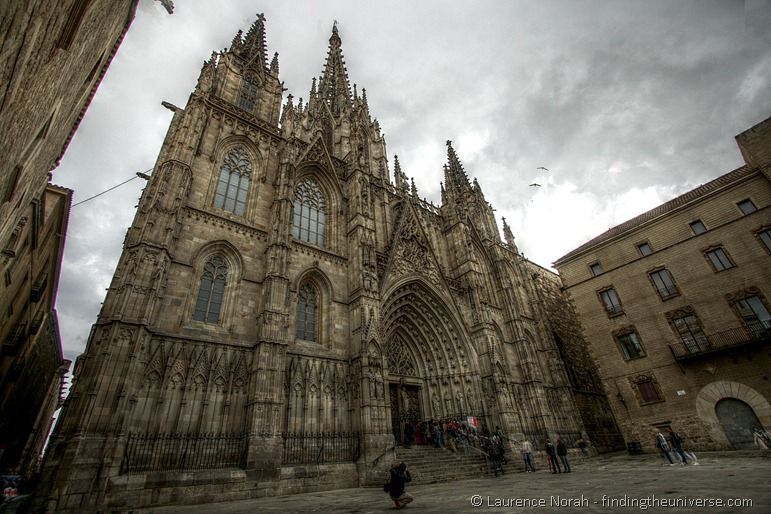
more
Today we were on an excursion, 3 hours flew by unnoticed, because it was very interesting! Mila talks at ease, glad that it was Mila who helped us get to know the old part of the city. During the tour, we learned a lot about the life of local residents. Mila also recommended an excellent restaurant, where we will go again and again. We definitely recommend it to everyone!)
more
474 responses to other offers of the organizer
Thank you Mila for an amazing tour of Barcelona! We enjoyed a lot. It was very interesting and informative. Mila is a very nice and positive girl.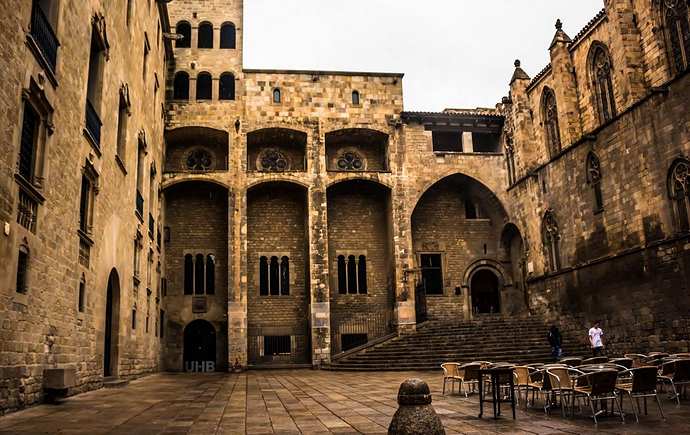
more
Mila is a wonderful storyteller, the tour was dynamic, informative and not boring. I recommend to everyone.
more
I would like to thank Mila for a wonderful introductory tour of Barcelona. We liked absolutely everything, from the proposed program to the presentation of material on it. Mila easily and cheerfully introduced us to a large amount of information. Everything was very clear and interesting even for children. And most importantly! We wanted to meet again, thank you very much Mila for such a wonderful acquaintance with the city! Family with three children))) April 5, 2023
more
We are very satisfied with the tour, Mila is competent and charming. I recommend this guide.
more
Thank you so much for a great tour.
more
Other tours in Barcelona
Evgen
4.93
261 reviews
Welcome to Barcelona!
Sightseeing walk from the Gothic Quarter to the Sagrada Familia and other works of Gaudí
€174 for the tour
Daria
4.91
399 reviews Gaudí
from € 156 per tour
Ludmila
4.97
38 reviews
Barcelona – a journey through time
Get to know the history of the city and be impressed by the architecture of different eras
€ 155 per tour
Frequently asked questions from travelers on tour
Where does the route start?
Plaza Catalunya.
May I ask a question before booking?
Yes, the organizer will answer your questions within 40 minutes. You do not need to pay, just create an order with a question. If something is not to your liking later, you can cancel the booking · Ask a question
When can a booking be cancelled?
Only in case of unfavorable weather conditions, for example, if there is a boat trip, and according to the weather forecast there is an abnormally strong wind. In this case, the guide will warn you about the cancellation, and we will return the prepayment to the card. In all other cases, the tour will take place.
Who else will be with me, group size?
If the tour is private, the guide will hold a meeting just for you and your company. If it is a group tour, there will be other participants on the tour, the size depends on the conditions of a particular tour.

